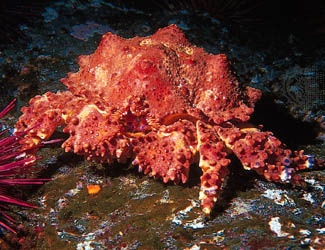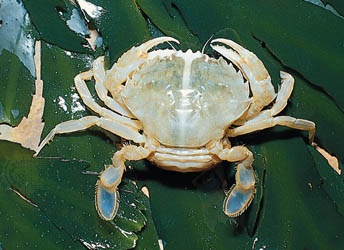crab
crustacean
Introduction
 any short-tailed member of the crustacean order Decapoda (phylum Arthropoda)—especially the brachyurans (infraorder Brachyura), or true crabs, but also other forms such as the anomurans (suborder Anomura), which include the hermit crabs. Decapods occur in all oceans, in fresh water, and on land; about 10,000 species have been described.
any short-tailed member of the crustacean order Decapoda (phylum Arthropoda)—especially the brachyurans (infraorder Brachyura), or true crabs, but also other forms such as the anomurans (suborder Anomura), which include the hermit crabs. Decapods occur in all oceans, in fresh water, and on land; about 10,000 species have been described.Unlike those of other decapods (e.g., shrimp, lobster, crayfish), crabs' tails are curled under the thorax, or midsection. The carapace (upper body shield) is usually broad. The first pair of legs is modified into chelae, or pincers.
Distribution and variety.
Most crabs live in the sea; even the land crabs, which are abundant in tropical countries, usually visit the sea occasionally and pass through their early stages in it. The river crab of southern Europe (the Lenten crab, Potamon fluviatile) is an example of the freshwater crabs abundant in most of the warmer regions of the world. As a rule, crabs breathe by gills, which are lodged in a pair of cavities beneath the sides of the carapace, but in the true land crabs the cavities become enlarged and modified so as to act as lungs for breathing air.
Walking or crawling is the usual mode of locomotion, and the familiar sidelong gait in the common shore crab is characteristic of most members of the group. The crabs of the family Portunidae, as well as some others, swim with great dexterity by means of their flattened paddle-shaped legs.
 Like many other crustaceans, crabs are often omnivorous and act as scavengers, but many are predatory and some are vegetarian.
Like many other crustaceans, crabs are often omnivorous and act as scavengers, but many are predatory and some are vegetarian.Though no crab is truly parasitic, some live commensally with other animals. One example is the little pea crab (Pinnotheridae), which lives within the shells of mussels and a variety of other mollusks, worm-tubes, and echinoderms and shares its hosts' food; another example is the coral-gall crab (Hapalocarcinidae), which irritates the growing tips of certain corals so that they grow to enclose the female in a stony prison. Many of the sluggish spider crabs (spider crab) (Majidae) cover their shells with growing seaweeds, zoophytes, and sponges, which afford them a very effective disguise.
The giant crab of Japan (Macrocheira kaempferi) and the Tasmanian crab (Pseudocarcinus gigas) are two of the largest known crustaceans. The former may span nearly 4 m (12 feet) from tip to tip of its outstretched legs. The Tasmanian crab, which may weigh well over 9 kg (20 pounds), has much shorter, stouter claws; the major one may be 43 cm 17 inches) long; the body, or carapace, of a very large specimen may measure 46 cm (18 inches) across. At the other extreme are tiny crabs measuring in adulthood scarcely more than a centimetre or two in length.
Better-known anomuran crabs are the hermit crabs (hermit crab), which live in empty shells discarded by gastropod mollusks. As the crab grows, it must find a larger shell to occupy. If the supply of empty shells of appropriate size is limited, competition for shells among hermit crabs can be severe. In tropical countries hermit crabs of the family Coenobitidae live on land, often at considerable distances from the sea, to which they must return to release their larvae. The large robber, or coconut, crab (another anomuran) of the Indo-Pacific islands (Birgus latro (robber crab)) has given up the habit of carrying a portable dwelling, and the upper surface of its abdomen has become covered by shelly plates.
As in most crustaceans, the young of nearly all crabs, when newly hatched from eggs, are very different from the parents. The larval stage, known as the zoea, is a minute transparent organism with a legless, rounded body, that swims and feeds in the plankton. After casting off its skin several times, the enlarging crab passes into a stage known as the megalopa, in which the body and limbs are more crablike, but the abdomen is large and not folded up under the thorax. After a further molt the animal assumes a form very similar to that of the adult. There are a few crabs, especially those living in fresh water, that do not pass through a series of free-living larval stages but instead leave the eggshell as miniature adults.
Economic importance.

 Many crabs are eaten by humans. The most important and valuable are the edible crab of the British and European coasts (Cancer pagurus; see photograph-->
Many crabs are eaten by humans. The most important and valuable are the edible crab of the British and European coasts (Cancer pagurus; see photograph--> ) and, in North America, the blue crab (Callinectes sapidus) of the Atlantic coast and the Dungeness crab (Cancer magister) of the Pacific coast. In the Indo-Pacific region the swimming crabs (swimming crab), Scylla and Portunus (see photograph-->
) and, in North America, the blue crab (Callinectes sapidus) of the Atlantic coast and the Dungeness crab (Cancer magister) of the Pacific coast. In the Indo-Pacific region the swimming crabs (swimming crab), Scylla and Portunus (see photograph--> ), related to the American blue crab, are among the most important sources of seafood. Commercially valuable anomurans are the lithodid (literally “stone”) crabs, of which the so-called king crab (Paralithodes camtschatica) found off Japan and in the Bering Sea and Alaskan waters is the most important.
), related to the American blue crab, are among the most important sources of seafood. Commercially valuable anomurans are the lithodid (literally “stone”) crabs, of which the so-called king crab (Paralithodes camtschatica) found off Japan and in the Bering Sea and Alaskan waters is the most important.- plain stitch
- plains wanderer
- Plainview
- plain weave
- planarian
- planation surface
- Planck
- Planck, Max
- Planck's constant
- Planck's radiation law
- plane
- planer
- planet
- planetarium
- Planetary data for Earth
- Planetary data for Jupiter
- Planetary data for Mars
- Planetary data for Mercury
- Planetary data for Neptune
- Planetary data for Saturn
- Planetary data for Uranus
- Planetary data for Venus
- planetary nebula
- planetesimal
- plane tree